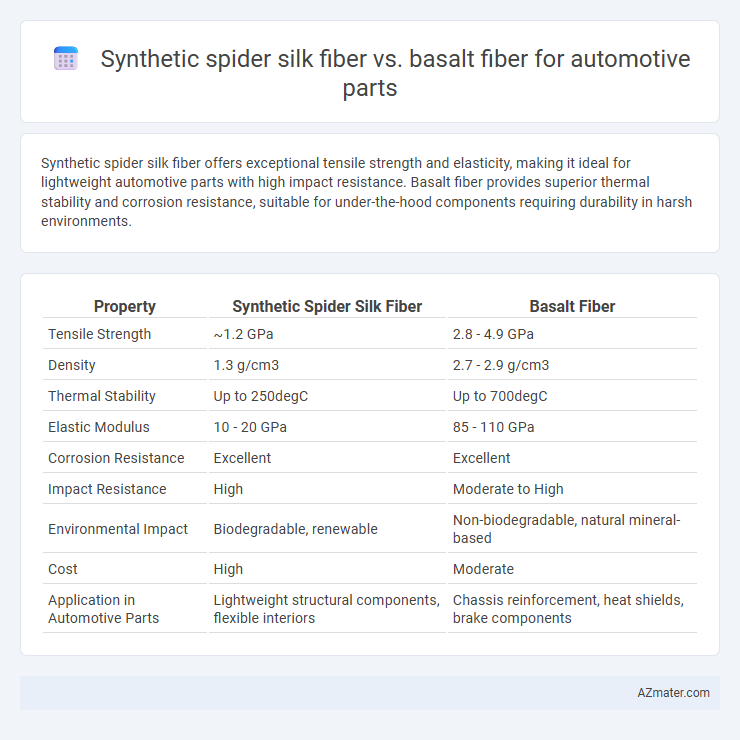Synthetic spider silk fiber offers exceptional tensile strength and elasticity, making it ideal for lightweight automotive parts with high impact resistance. Basalt fiber provides superior thermal stability and corrosion resistance, suitable for under-the-hood components requiring durability in harsh environments.
Table of Comparison
| Property | Synthetic Spider Silk Fiber | Basalt Fiber |
|---|---|---|
| Tensile Strength | ~1.2 GPa | 2.8 - 4.9 GPa |
| Density | 1.3 g/cm3 | 2.7 - 2.9 g/cm3 |
| Thermal Stability | Up to 250degC | Up to 700degC |
| Elastic Modulus | 10 - 20 GPa | 85 - 110 GPa |
| Corrosion Resistance | Excellent | Excellent |
| Impact Resistance | High | Moderate to High |
| Environmental Impact | Biodegradable, renewable | Non-biodegradable, natural mineral-based |
| Cost | High | Moderate |
| Application in Automotive Parts | Lightweight structural components, flexible interiors | Chassis reinforcement, heat shields, brake components |
Introduction to Synthetic Spider Silk Fiber and Basalt Fiber
Synthetic spider silk fiber exhibits remarkable tensile strength, elasticity, and lightweight properties, making it an innovative material for automotive parts requiring flexibility and durability. Basalt fiber, derived from volcanic rock, offers excellent thermal resistance, high tensile strength, and environmental sustainability, making it suitable for structural components in vehicles. Comparing both, synthetic spider silk fiber excels in dynamic impact absorption and flexibility, whereas basalt fiber provides superior heat resistance and stiffness for automotive applications.
Material Origin and Production Processes
Synthetic spider silk fiber is produced through bioengineering techniques that replicate the natural proteins found in spider silk, involving microbial fermentation or genetic modification to create highly tensile and lightweight fibers. Basalt fiber originates from natural volcanic basalt rock, which is melted and extruded into continuous fibers through a high-temperature drawing process, resulting in a material known for its thermal stability and corrosion resistance. The production of synthetic spider silk is energy-intensive and reliant on biotechnology, whereas basalt fiber manufacturing uses abundant natural resources and established melting and spinning technologies.
Mechanical Strength Comparison
Synthetic spider silk fiber exhibits exceptional tensile strength and elasticity, often surpassing basalt fiber in terms of toughness and flexibility, which enhances impact resistance in automotive parts. Basalt fiber, known for its high compressive strength and thermal stability, offers superior rigidity and vibration damping but is generally less flexible than synthetic spider silk. The mechanical strength comparison highlights synthetic spider silk as a promising lightweight alternative with superior energy absorption, while basalt fiber remains advantageous for structural durability and heat resistance in automotive applications.
Weight and Density Analysis
Synthetic spider silk fiber boasts an exceptionally low density of approximately 1.3 g/cm3, significantly lighter than basalt fiber, which typically ranges around 2.7-2.9 g/cm3. This density advantage directly translates to reduced weight components in automotive applications, enhancing fuel efficiency and vehicle handling. Despite its lightweight nature, synthetic spider silk maintains impressive tensile strength and durability, often outperforming basalt fiber in strength-to-weight ratio.
Thermal and Chemical Resistance Properties
Synthetic spider silk fiber exhibits exceptional thermal stability with a decomposition temperature exceeding 300degC, outperforming traditional basalt fiber, which typically withstands temperatures up to 600degC but with reduced structural integrity under fluctuating thermal cycles. In terms of chemical resistance, synthetic spider silk fiber resists degradation from acids, bases, and solvents due to its protein-based biopolymer structure, while basalt fiber offers superior resistance to alkalis and environmental corrosion but can be vulnerable to strong acids. These properties make synthetic spider silk fiber particularly advantageous for automotive components requiring durability under high thermal stress and chemical exposure, whereas basalt fiber remains preferred for applications demanding robust mechanical strength and resistance to harsh alkaline environments.
Environmental Impact and Sustainability
Synthetic spider silk fiber offers a significantly lower environmental impact compared to basalt fiber due to its biodegradable properties and production from renewable bio-based materials. Basalt fiber, while strong and durable, requires energy-intensive mining and processing of volcanic rock, leading to higher carbon emissions and resource depletion. The sustainability of synthetic spider silk in automotive parts is enhanced by its potential for zero-waste manufacturing and reduced reliance on non-renewable resources.
Cost and Scalability for Automotive Manufacturing
Synthetic spider silk fiber offers exceptional strength-to-weight ratio and biodegradability but remains costly and limited in large-scale production due to complex bioengineering processes. Basalt fiber provides a more economical and scalable alternative for automotive manufacturing, benefiting from abundant raw materials and established industrial production methods. The cost-effectiveness and mass production capabilities of basalt fiber currently make it preferable for automotive parts requiring durability and affordability.
Performance in Automotive Applications
Synthetic spider silk fiber offers exceptional tensile strength and elasticity, making it ideal for automotive parts requiring lightweight durability and energy absorption. Basalt fiber provides superior thermal stability and chemical resistance, enhancing performance in under-the-hood components exposed to extreme conditions. Both materials improve vehicle safety and fuel efficiency, with synthetic spider silk excelling in flexibility and basalt fiber in heat resistance.
Challenges and Limitations
Synthetic spider silk fiber offers exceptional tensile strength and elasticity, making it lightweight yet durable for automotive parts; however, its high production cost and scalability issues limit widespread adoption. Basalt fiber provides excellent thermal stability, corrosion resistance, and cost-effectiveness, but its brittleness and lower impact resistance compared to synthetic spider silk pose challenges for structural applications. Both materials face integration difficulties with existing manufacturing processes and require further research to optimize composite performance and cost-efficiency in automotive components.
Future Prospects and Innovation in Automotive Fiber Materials
Synthetic spider silk fiber exhibits exceptional tensile strength and elasticity, making it a promising candidate for lightweight, high-performance automotive parts that demand durability and flexibility. Basalt fiber offers excellent thermal resistance and environmental sustainability, positioning it as an innovative alternative for components requiring heat tolerance and eco-friendly materials. Future prospects hinge on integrating these fibers into composite materials to enhance vehicle efficiency, reduce emissions, and enable advanced manufacturing techniques like 3D printing and smart fabric incorporation.

Infographic: Synthetic spider silk fiber vs Basalt fiber for Automotive part
 azmater.com
azmater.com